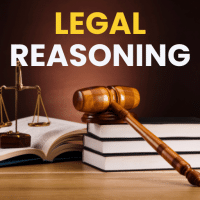CLAT Exam > CLAT Questions > Directions: In making a decision about an imp...
Start Learning for Free
Directions: In making a decision about an important question, it is desirable to distinguish between a 'strong' argument and a 'weak' argument. A 'strong' argument must be both important and directly related to the question. A 'weak' argument may not be directly related to the question and may be of minor importance or may be related to the trivial aspect of the question. The question below is followed by two arguments numbered I and II. You have to decide which of the arguments is 'strong' and which is 'weak'.
Statement: Should all the universities in the country switch over to grade system rather than awarding marks?
Arguments:
I. Yes, with this the students falling in a particular range of marks can be treated on par.
II. No, it will be difficult to rank the students when required to be short-listed.
- a)if only argument I is strong
- b)if only argument II is strong.
- c)if either argument I or II is strong.
- d)if neither argument I nor II is strong.
- e)if both arguments I and II are strong
Correct answer is option 'E'. Can you explain this answer?
Verified Answer
Directions: In making a decision about an important question, it is de...
The correct option is E.
Argument I is strong because it states genuine reason. Argument II is also strong because it is true.
Argument I is strong because it states genuine reason. Argument II is also strong because it is true.

|
Explore Courses for CLAT exam
|

|
Question Description
Directions: In making a decision about an important question, it is desirable to distinguish between a strong argument and a weak argument. A strong argument must be both important and directly related to the question. A weak argument may not be directly related to the question and may be of minor importance or may be related to the trivial aspect of the question. The question below is followed by two arguments numbered I and II. You have to decide which of the arguments is strong and which is weak.Statement: Should all the universities in the country switch over to grade system rather than awarding marks?Arguments:I. Yes, with this the students falling in a particular range of marks can be treated on par.II. No, it will be difficult to rank the students when required to be short-listed.a)if only argument I is strongb)if only argument II is strong.c)if either argument I or II is strong.d)if neither argument I nor II is strong.e)if both arguments I and II are strongCorrect answer is option 'E'. Can you explain this answer? for CLAT 2025 is part of CLAT preparation. The Question and answers have been prepared according to the CLAT exam syllabus. Information about Directions: In making a decision about an important question, it is desirable to distinguish between a strong argument and a weak argument. A strong argument must be both important and directly related to the question. A weak argument may not be directly related to the question and may be of minor importance or may be related to the trivial aspect of the question. The question below is followed by two arguments numbered I and II. You have to decide which of the arguments is strong and which is weak.Statement: Should all the universities in the country switch over to grade system rather than awarding marks?Arguments:I. Yes, with this the students falling in a particular range of marks can be treated on par.II. No, it will be difficult to rank the students when required to be short-listed.a)if only argument I is strongb)if only argument II is strong.c)if either argument I or II is strong.d)if neither argument I nor II is strong.e)if both arguments I and II are strongCorrect answer is option 'E'. Can you explain this answer? covers all topics & solutions for CLAT 2025 Exam. Find important definitions, questions, meanings, examples, exercises and tests below for Directions: In making a decision about an important question, it is desirable to distinguish between a strong argument and a weak argument. A strong argument must be both important and directly related to the question. A weak argument may not be directly related to the question and may be of minor importance or may be related to the trivial aspect of the question. The question below is followed by two arguments numbered I and II. You have to decide which of the arguments is strong and which is weak.Statement: Should all the universities in the country switch over to grade system rather than awarding marks?Arguments:I. Yes, with this the students falling in a particular range of marks can be treated on par.II. No, it will be difficult to rank the students when required to be short-listed.a)if only argument I is strongb)if only argument II is strong.c)if either argument I or II is strong.d)if neither argument I nor II is strong.e)if both arguments I and II are strongCorrect answer is option 'E'. Can you explain this answer?.
Directions: In making a decision about an important question, it is desirable to distinguish between a strong argument and a weak argument. A strong argument must be both important and directly related to the question. A weak argument may not be directly related to the question and may be of minor importance or may be related to the trivial aspect of the question. The question below is followed by two arguments numbered I and II. You have to decide which of the arguments is strong and which is weak.Statement: Should all the universities in the country switch over to grade system rather than awarding marks?Arguments:I. Yes, with this the students falling in a particular range of marks can be treated on par.II. No, it will be difficult to rank the students when required to be short-listed.a)if only argument I is strongb)if only argument II is strong.c)if either argument I or II is strong.d)if neither argument I nor II is strong.e)if both arguments I and II are strongCorrect answer is option 'E'. Can you explain this answer? for CLAT 2025 is part of CLAT preparation. The Question and answers have been prepared according to the CLAT exam syllabus. Information about Directions: In making a decision about an important question, it is desirable to distinguish between a strong argument and a weak argument. A strong argument must be both important and directly related to the question. A weak argument may not be directly related to the question and may be of minor importance or may be related to the trivial aspect of the question. The question below is followed by two arguments numbered I and II. You have to decide which of the arguments is strong and which is weak.Statement: Should all the universities in the country switch over to grade system rather than awarding marks?Arguments:I. Yes, with this the students falling in a particular range of marks can be treated on par.II. No, it will be difficult to rank the students when required to be short-listed.a)if only argument I is strongb)if only argument II is strong.c)if either argument I or II is strong.d)if neither argument I nor II is strong.e)if both arguments I and II are strongCorrect answer is option 'E'. Can you explain this answer? covers all topics & solutions for CLAT 2025 Exam. Find important definitions, questions, meanings, examples, exercises and tests below for Directions: In making a decision about an important question, it is desirable to distinguish between a strong argument and a weak argument. A strong argument must be both important and directly related to the question. A weak argument may not be directly related to the question and may be of minor importance or may be related to the trivial aspect of the question. The question below is followed by two arguments numbered I and II. You have to decide which of the arguments is strong and which is weak.Statement: Should all the universities in the country switch over to grade system rather than awarding marks?Arguments:I. Yes, with this the students falling in a particular range of marks can be treated on par.II. No, it will be difficult to rank the students when required to be short-listed.a)if only argument I is strongb)if only argument II is strong.c)if either argument I or II is strong.d)if neither argument I nor II is strong.e)if both arguments I and II are strongCorrect answer is option 'E'. Can you explain this answer?.
Solutions for Directions: In making a decision about an important question, it is desirable to distinguish between a strong argument and a weak argument. A strong argument must be both important and directly related to the question. A weak argument may not be directly related to the question and may be of minor importance or may be related to the trivial aspect of the question. The question below is followed by two arguments numbered I and II. You have to decide which of the arguments is strong and which is weak.Statement: Should all the universities in the country switch over to grade system rather than awarding marks?Arguments:I. Yes, with this the students falling in a particular range of marks can be treated on par.II. No, it will be difficult to rank the students when required to be short-listed.a)if only argument I is strongb)if only argument II is strong.c)if either argument I or II is strong.d)if neither argument I nor II is strong.e)if both arguments I and II are strongCorrect answer is option 'E'. Can you explain this answer? in English & in Hindi are available as part of our courses for CLAT.
Download more important topics, notes, lectures and mock test series for CLAT Exam by signing up for free.
Here you can find the meaning of Directions: In making a decision about an important question, it is desirable to distinguish between a strong argument and a weak argument. A strong argument must be both important and directly related to the question. A weak argument may not be directly related to the question and may be of minor importance or may be related to the trivial aspect of the question. The question below is followed by two arguments numbered I and II. You have to decide which of the arguments is strong and which is weak.Statement: Should all the universities in the country switch over to grade system rather than awarding marks?Arguments:I. Yes, with this the students falling in a particular range of marks can be treated on par.II. No, it will be difficult to rank the students when required to be short-listed.a)if only argument I is strongb)if only argument II is strong.c)if either argument I or II is strong.d)if neither argument I nor II is strong.e)if both arguments I and II are strongCorrect answer is option 'E'. Can you explain this answer? defined & explained in the simplest way possible. Besides giving the explanation of
Directions: In making a decision about an important question, it is desirable to distinguish between a strong argument and a weak argument. A strong argument must be both important and directly related to the question. A weak argument may not be directly related to the question and may be of minor importance or may be related to the trivial aspect of the question. The question below is followed by two arguments numbered I and II. You have to decide which of the arguments is strong and which is weak.Statement: Should all the universities in the country switch over to grade system rather than awarding marks?Arguments:I. Yes, with this the students falling in a particular range of marks can be treated on par.II. No, it will be difficult to rank the students when required to be short-listed.a)if only argument I is strongb)if only argument II is strong.c)if either argument I or II is strong.d)if neither argument I nor II is strong.e)if both arguments I and II are strongCorrect answer is option 'E'. Can you explain this answer?, a detailed solution for Directions: In making a decision about an important question, it is desirable to distinguish between a strong argument and a weak argument. A strong argument must be both important and directly related to the question. A weak argument may not be directly related to the question and may be of minor importance or may be related to the trivial aspect of the question. The question below is followed by two arguments numbered I and II. You have to decide which of the arguments is strong and which is weak.Statement: Should all the universities in the country switch over to grade system rather than awarding marks?Arguments:I. Yes, with this the students falling in a particular range of marks can be treated on par.II. No, it will be difficult to rank the students when required to be short-listed.a)if only argument I is strongb)if only argument II is strong.c)if either argument I or II is strong.d)if neither argument I nor II is strong.e)if both arguments I and II are strongCorrect answer is option 'E'. Can you explain this answer? has been provided alongside types of Directions: In making a decision about an important question, it is desirable to distinguish between a strong argument and a weak argument. A strong argument must be both important and directly related to the question. A weak argument may not be directly related to the question and may be of minor importance or may be related to the trivial aspect of the question. The question below is followed by two arguments numbered I and II. You have to decide which of the arguments is strong and which is weak.Statement: Should all the universities in the country switch over to grade system rather than awarding marks?Arguments:I. Yes, with this the students falling in a particular range of marks can be treated on par.II. No, it will be difficult to rank the students when required to be short-listed.a)if only argument I is strongb)if only argument II is strong.c)if either argument I or II is strong.d)if neither argument I nor II is strong.e)if both arguments I and II are strongCorrect answer is option 'E'. Can you explain this answer? theory, EduRev gives you an
ample number of questions to practice Directions: In making a decision about an important question, it is desirable to distinguish between a strong argument and a weak argument. A strong argument must be both important and directly related to the question. A weak argument may not be directly related to the question and may be of minor importance or may be related to the trivial aspect of the question. The question below is followed by two arguments numbered I and II. You have to decide which of the arguments is strong and which is weak.Statement: Should all the universities in the country switch over to grade system rather than awarding marks?Arguments:I. Yes, with this the students falling in a particular range of marks can be treated on par.II. No, it will be difficult to rank the students when required to be short-listed.a)if only argument I is strongb)if only argument II is strong.c)if either argument I or II is strong.d)if neither argument I nor II is strong.e)if both arguments I and II are strongCorrect answer is option 'E'. Can you explain this answer? tests, examples and also practice CLAT tests.

|
Explore Courses for CLAT exam
|

|
Signup for Free!
Signup to see your scores go up within 7 days! Learn & Practice with 1000+ FREE Notes, Videos & Tests.


















